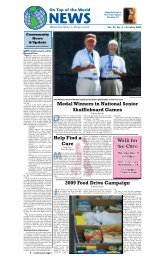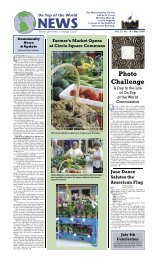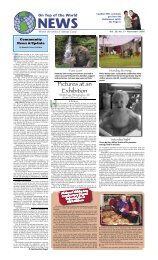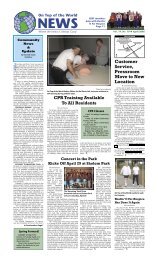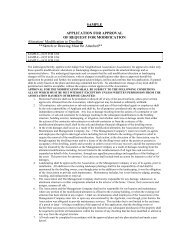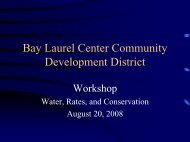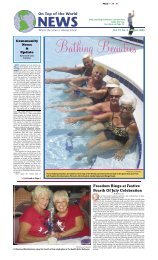Aeration and Topdressing for the 21st Century - USGA Green ...
Aeration and Topdressing for the 21st Century - USGA Green ...
Aeration and Topdressing for the 21st Century - USGA Green ...
- No tags were found...
Create successful ePaper yourself
Turn your PDF publications into a flip-book with our unique Google optimized e-Paper software.
matter in <strong>the</strong> upper portion of <strong>the</strong> soil profIle(Carrow et al., 2002). Core aeration <strong>and</strong> s<strong>and</strong>topdressing are <strong>the</strong> two most effective means tocontrol <strong>the</strong> content <strong>and</strong> distribution of organicmatter in this zone. The scientifIc literature is fullof references to <strong>the</strong> benefIts of core aeration <strong>and</strong>s<strong>and</strong> topdressing. Un<strong>for</strong>tunately, details on howmuch aeration <strong>and</strong> topdressing are needed arelacking.The moment any type of grass is planted ona putting green rootzone mix, <strong>the</strong> soil physicalproperties in <strong>the</strong> upperfew inches of <strong>the</strong> rootzonebegin to change(Habeck <strong>and</strong> Christians,2000; Curtis, 2001).In a new putting green<strong>the</strong> cycle of rootgrowth, decline, <strong>and</strong>new growth is repeatedyear after year. Rootsgrow down through<strong>the</strong> soil in <strong>the</strong> large soilpores (macropores) <strong>and</strong> provide <strong>the</strong> plant withneeded water, oxygen, <strong>and</strong> nutrients. When aroot is no longer viable, it begins to plug up soilmacropores <strong>and</strong> can hinder <strong>the</strong> ability of livingplants to function.Dr. Carrow conducted extensive research(Carrow, 1998) in <strong>the</strong> mid-1990s on <strong>the</strong> organicmatter dynamics in <strong>the</strong> rootzone of s<strong>and</strong>-basedputting greens. He concluded as organic matter ina s<strong>and</strong>-based putting green reaches 3-4% byweight, <strong>the</strong> percentage of soil macropores beginsto decrease. The reduction of pore space has threedistinct implications, <strong>and</strong> a host of primary problemscan be expected: 1) The diffUsion of oxygeninto <strong>the</strong> rootzone begins to decline. Oxygen isvital <strong>for</strong> plant growth as well as soil microorganismbalance <strong>and</strong> function. 2) Water infiltration decreases,which can result in puddling <strong>and</strong> saturationof <strong>the</strong> surface. 3) Moisture content in <strong>the</strong>upper rootzone increases, which can make <strong>the</strong>surface less fIrm. The decrease in macropores(aeration pores) is accompanied by an increase incapillary or water-holding pores.If organic matter accumulation begins toexceed 3-4% by weight, putting greens becomevulnerable to a host of secondary problems suchas disease, wet wilt, soft surfaces, poor root growth,black layer, <strong>and</strong> more frequent high-temperatureinjury. These secondary problems are often calledsummer bentgrass decline (Carrow et al., 2002),<strong>and</strong> trYing to treat <strong>the</strong>m curatively can be expensive.Theyoccur often at courses that have notadequately aerated <strong>and</strong> topdressed <strong>the</strong> greens.Many of <strong>the</strong>se courses are doomed to many yearsof frustration because <strong>the</strong>y are not willing tomake <strong>the</strong> ef<strong>for</strong>t to do <strong>the</strong> additional aeration <strong>and</strong>topdressing needed to prevent <strong>the</strong> situation.Dr. Carrow's research shows that core aeration<strong>and</strong> applYing s<strong>and</strong> can help dilute organic accumulation<strong>and</strong> create new macropores. The remainderof this article will be devoted to developing anaeration <strong>and</strong> topdressing program that keepsorganic matter levels below 3-4% by weight. Thisproactive approach ultimately will cause less disruption<strong>and</strong> be less expensive than trYing toalleviate primary <strong>and</strong> secondary problems througha curative approach.The organic matter dilution program is a catch-allterm that includes core aeration accompanied bys<strong>and</strong> topdressing to fill <strong>the</strong> holes <strong>and</strong> s<strong>and</strong> topdressingapplied directly to <strong>the</strong> surface. Referencesto core aeration refer only to hollow-tine aerationat a st<strong>and</strong>ard depth of 3 inches. <strong>Aeration</strong> depthcan vary signifIcantly based upon machine <strong>and</strong>type of tine used. Deep-tine aeration or similarpractices designed to correct deep rootzone issuesare not considered. Suiface topdressing refers to s<strong>and</strong>applied directly to <strong>the</strong> turf grass canopy. Light,medium, <strong>and</strong> heavy topdressing applications areapproximately 0.50 ft: per 1,000 ft?, 2.0 ft: per1,000 fe, <strong>and</strong> 4.0 fe per 1,000 ft?, respectively.AERATION AND TOPDRESSINGRECOMMENDATIONSThe case has been made <strong>for</strong> <strong>the</strong> importance ofusing core aeration <strong>and</strong> s<strong>and</strong> topdressing to dilute<strong>the</strong> accumulation of organic matter. The questionis, How much of each needs to be done? We proposeanswering this question in a slightly differentway. The answer requires linking <strong>the</strong> topics ofaeration <strong>and</strong> topdressing toge<strong>the</strong>r. We link <strong>the</strong>two toge<strong>the</strong>r because <strong>the</strong>y are <strong>the</strong> key elements inan organic matter dilution program. Core aerationremoves organic matter. Filling <strong>the</strong> holes withs<strong>and</strong> makes sure those columns stay open. Dustingsof s<strong>and</strong> applied directly to <strong>the</strong> surface alsohelp manage organic matter accumulation.ApplYing at least 40-50 ft: of s<strong>and</strong> per 1,000 ft?per year is recommended to keep organic mattercontent below 3-4% by weight in <strong>the</strong> upperportion of <strong>the</strong> rootzone. Although this recommendationis brief, underst<strong>and</strong>ing all its ramifIcationsis more complex, <strong>and</strong> it should stimulate2 GREEN SECTION RECORD



